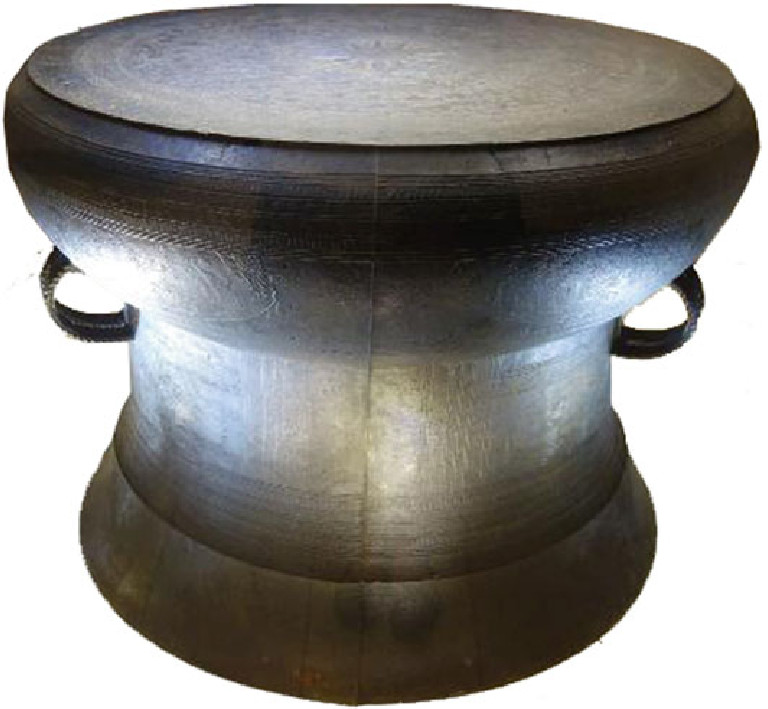The 2,500-year-old Bronze Drum is unlike anything else in the world—a masterpiece of design, meaning, and mystery. Its bottomless, open structure, composed of three distinct parts—the tympanum (face), body, and foot—symbolizes the Cosmic Egg[i], the universe, creation itself, and the eternal kiss of Âu Cơ and Lạc Long Quân. It is more than an artifact; it is alive, vibrating with profound wisdom.

Figure 1: 3-Part Structure of the Ngọc Lũ Bronze Drum
Movement and Stillness: The Dance of Sound and Silence
The drum embodies both motion and stillness, sound and emptiness—a poetic and profound symbol[ii].
- The drumming—its rhythms, movements, and expanding vibrations—mirrors the spiraling cycles of creation and life’s unfolding dance[iii].
- It pulses with the dynamism of growth and transformation, resonating through rituals, celebrations, and cultural traditions.
But just as powerful as the sound is the silence between beats—a space of timeless, spaceless consciousness. The emptiness within the drum reminds us of the formless foundation of all things, the Âm beneath the Dương, the stillness that holds the universe together.
A Bridge Between Worlds
This duality—sound and silence, movement and stillness—makes the drum not just a symbol but a living bridge between:
- Physical and spiritual
- Audible and inaudible
- Manifest and unmanifest
The Cosmic Egg imagery ties it back to the Center—the one source from which all creation emerges, forever expanding yet always connected to its origin. Its open-bottom design suggests infinity—no final boundary, only endless connection. This mirrors the sages’ vision of the universe as a fractal, an eternal spiral of being and becoming.
More Than a Symbol—An Active Force
The drum is not merely a representation of the universe’s rhythm—it participates in it. It pulses with life, energy, and meaning, inviting us to listen—not just to the beats but to the silent, infinite resonance within.
The concept of a primordial sound, often represented as “Aum” in Hinduism, is central to many creation narratives. This sound is believed to have initiated the universe, setting everything into motion through vibration.
In the Judeo-Christian tradition, the Bible states, “In the beginning was the Word,” (John 1:1) highlighting the significance of sound in creation. The term “Word” (Logos in Greek) signifies not just spoken language but also reason and order. This reflects a broader understanding across various cultures where spoken words or sounds are seen as creative forces.
In the modern time, Big Bang theory suggests that the universe began with a massive explosion, which can be metaphorically related to a “sound” that initiated all matter and energy.
[i] The anatomy of the bronze drums reveals that the morphology and structure of the bronze drums reflect the entire spectrum of the cosmogony (cosmogeny). In general, the bronze drums are purposely made with open bottoms and have yin-yang characters. The different morphology of the drums portrays the different aspects of cosmogony.
[ii] Lao Tzu’s Tao Te Ching describes the Tao as a “hollow vessel” (Chapter 4: “The Tao is empty, yet in use it is inexhaustible; fathomless, it seems to be the source of all things”), and the emphasis on emptiness as strength (Chapter 11: “We shape clay into a pot, but it is the emptiness inside that holds whatever we want”) parallel the Drum’s hollowness and emptiness.
[iii] Hazrat Inayat Khan, a prominent Sufi master and musician, posits that sound is a fundamental aspect of existence, serving as a universal language that transcends cultural and linguistic barriers. He asserts that everything in the universe originates from sound vibrations, making sound a bridge between the individual soul and the divine.
